Right in the heart of an inner district in Budapest lies a 7700 square metre wild, at first sight untamed green space, sandwiched between unassuming residential buildings. Walking in the area, one is surprised to find Szeszgyár, this vast ecofeminist and queer community garden behind the graffiti-filled walls, away from sight. Szeszgyár is different to most community gardens. Its core principles are rewilding and ecofeminism, placing the initiative in a unique ecological, political and social context. Its community encourages us to rethink our relationship with our environment as collaboration rather than destruction or exploitation, and overcome binaries such as “human/nature” or “natural/unnatural”. The space is located on the vacant grounds of a long-abandoned distillery factory where it gets its name “Szeszgyár” (Distillery factory). The owners of the plot have given permission for the group to use the land until it is sold.
In this interview we speak with Adriam, one of the garden’s main organisers, who tells us about the history of the land, the role of the principles of ecofeminism, queer ecology, permaculture, and rewilding in revitalising the land, the relationship with the municipality and neighbours, and the precarious situations they have to navigate within Hungary’s political landscape.
Can you tell us about the history about this wild, green space in the middle of the city?
This space used to be a distillery factory for a very long time. So the name of the space and the street makes reference to that. The factory was functioning for a long time, but like many other factories in Hungary, during the regime change and democratisation process in the 1990s, it was sold to foreign capital, and then not long after it closed down, and was left vacant. Later it was purchased by a new owner with the purpose of reselling for a much higher price to build new, luxury apartment blocks. It is a massive space, with 7700 square meters. It has been on sale for 20 years already, and has not yet found a buyer.
How have you found this vacant plot?
About two and a half years ago a couple moved into a ground floor flat, just in front of this vacant lot. They saw this huge plot of land right next to them which was completely empty and full of rubbish. They decided to find the owners. They managed to locate them and reached out to them asking if they would be able to use that plot of land and the owners said yes! We opened up the space in 2021. Since then the couple have left Hungary and some others including myself are now running the space.

What are the conditions of use and do you have a contract or deal in place? How long can you stay here and use the space?
There were some conditions of course, like long-lasting structures cannot be built. We can stay here until it is sold so there is no rush. The price is too high, but the owners wish to sell for that price. I think eventually they will be able to as this neighbourhood is going through steep gentrification. 10-15 years ago, you couldn’t imagine what this area looked like, just 15 minutes walk from here were run-down houses inhabited by very poor people, now luxury apartments and malls stand in their place. Housing prices are increasing sharply in Budapest so they know it’s going to be so much more expensive in the future. Plus, just in the last couple of years several new buildings have been built in the near vicinity of Szeszgyár, so the owners know that they will be able to sell it for the price they want. And in the meantime, they are relaxed about us being here as there are no upkeep costs. The costs are with us, we are paying for electricity and water through the continuing to rent the same ground floor flat the original group organisers had.
How is this space different from other community gardens?
As you can see this is not a typical garden. There are a lot of wild plants growing here. We want to rewild the place, having a very positive effect on biodiversity. There are plenty of insects that you won’t see anywhere else in the city but here. As you have so many insects, you get birds, and then because there are birds, we also have cats. They all enrich biodiversity. There is a lake here, and sometimes ducks come through from the nearby Orczy garden, or from the City Park. This space is rich with wildlife.

This plot has been on sale for about 20 years. What issues or challenges might be delaying finding a new buyer?
It is difficult to sell this place because it is hard to remove all the waste products that fill the land. On top of that, under the grass, unseen to the human eye, there is a huge basement building that was used during the operation of the factory. You would also need to remove that, so this will make the venture more costly. Plus they would need to deal with the toxic materials seeped into the ground, and ship it somewhere. From the moment that they find a buyer, it will take at least half a year or a year to get to the point of being able to start the construction of the new building. When we started opening up this space, we had to first clear it of all the rubbish and deposits of items left from the factory.
How do you create a sense of community at Szeszgyár?
One of the main driving motivations about this place is to create a community or a meeting place. We felt that one of the things that can bring a community together is composting. So we created the compost pile and also a wooden structured compost toilet. The compost soil is so rich, it’s very easy to plant anything in it, such as squash, potato. As the former factory left a lot of metals in the soil, we had to create a separate layer of soil in raised beds. We plant a lot of vegetables on these raised grounds. We also have herbs such as mint and lemongrass. People like to come and leave their compost; others who come bring their dogs and visit us as a community garden.
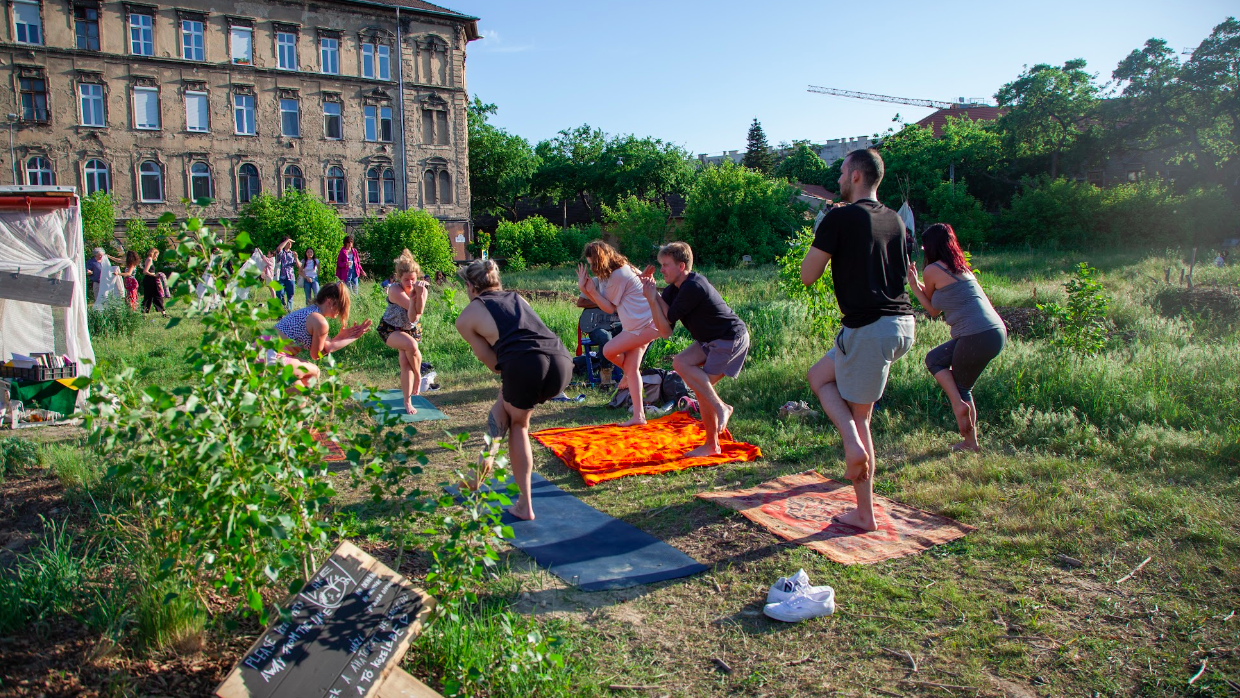
Szeszgyár identifies itself as an ecofeminist space. Can you tell us about the ecofeminist guiding principles?
It is a theory that comes from feminism and queer theory. Nowadays in our culture there is a binary understanding between nature and culture, or between man and woman. Ecofeminism tries to question and break those binary approaches and understandings. Ecofeminism looks at the exploitation that happens between those parts. It looks at how industry and culture exploit nature, how we can work in a different way. We are a vegan space, we only cook vegan meals. For us, veganism is part of ecofeminism in the sense that we don’t exploit nature through exploiting animals. We work on the basis of permaculture which means we don’t use any kind of artificial fertilisers. With regards to ecofeminism, it means we try to live together with nature. We are not doing anything to “get the most” out of the land. We work with it. We use compost to keep the soil more fertile. We build with reused materials. For example, our outdoor kitchen stove is made of clay. It takes a bit of time to heat up but then it’s fantastic. It works like a typical wood stove, clay is very good at keeping temperatures
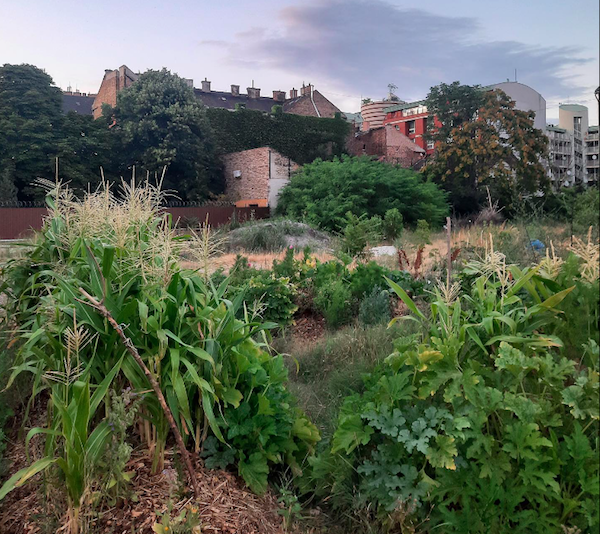
One of your core principles is rewilding, which means restoring an area of land to its natural uncultivated state, with the reintroduction of indigenous species that disappeared in the past. Can you tell us about the biodiversity of this space and its connection to rewilding?
If you look at the grass, it looks like random grass, but we are actually working on it. We take away the invasive species. We don’t take out all of them because that would be very damaging. The problem with the maintenance of this place is that we don’t know how long we’re going to stay here. If we knew, then we would plant trees that can take up to three or five years to grow. But since we don’t know how long we are able to stay, we have to rly on some trees that ar invasive. We don’t let most of them grow when they start appearing because there are already enough of them. If you leave a plot of land in Budapest, normally you will have a lot of the same kinds of plants. So you have to help biodiversity by bringing in other plants that are local, to help rewilding. Rewilding is not just “leaving the land to its own devices and forgeting about it”. You have to do work on the land to help indigenous species grow back. We are in the process of mapping the species grown here. For example, it’s very funny because some plants that are usually edible such as Jerusalem artichokes and the specifically Hungarian csicsóka just grew two or three years ago without us planting them!
What kind of people are drawn to Szeszgyár and form part of the community?
It depends, it is difficult to generalise. Some people are very interested in our values and principles, and will eventually become active and help out, while some other people come a lot but then their involvement will phase out. It depends a lot on their personality. There are also those who are only interested in coming here with their dogs. There are many different cases of people who want to use this space.
What activities do you do?
One of the reasons we grow vegetables is because one of our main activities is cooking together. We invite people from our Facebook group or the neighbourhood, and we cook together while discussing specific topics.

We have regular markets at Szeszgyár. They are mostly flea markets based on exchange. It’s not just about clothes, people give massages, make tattoos, anything in exchange for the items at the market. We also have a lot of concerts and we also have cinema nights, we project onto a massive wall surrounding the space.
How do you manage the land financially?
We receive donations from our events and workshops. For example, we just did a workshop about permaculture, about microgreens. While none of the events have a fixed price, there is a recommended donation. If somebody doesn’t have the money, they can join anyway. We immediately use the money from donations to pay for rent, water and electricity.
What kind of expertise do you have in the core group managing the space?
We have a former biology teacher, we have an expert on composting, we have an expert on mushrooms as we do a lot of work with mushrooms. One of the volunteers is an architect and knows about landscape gardening and how to create a park.
Do you work or collaborate with any institutions, municipalities, schools, or universities?
We work with institutions such as the kindergarten just the other side of the walls and also the 8th district municipality. For example, there is a Hungarian tradition that they burn a doll to just “scare away the winter”, a tradition that takes place in spring. The past two years the municipality has organised this event here. The municipality also has collaborations with organisations that have events here. Schools can also visit and check out how they could use this space.
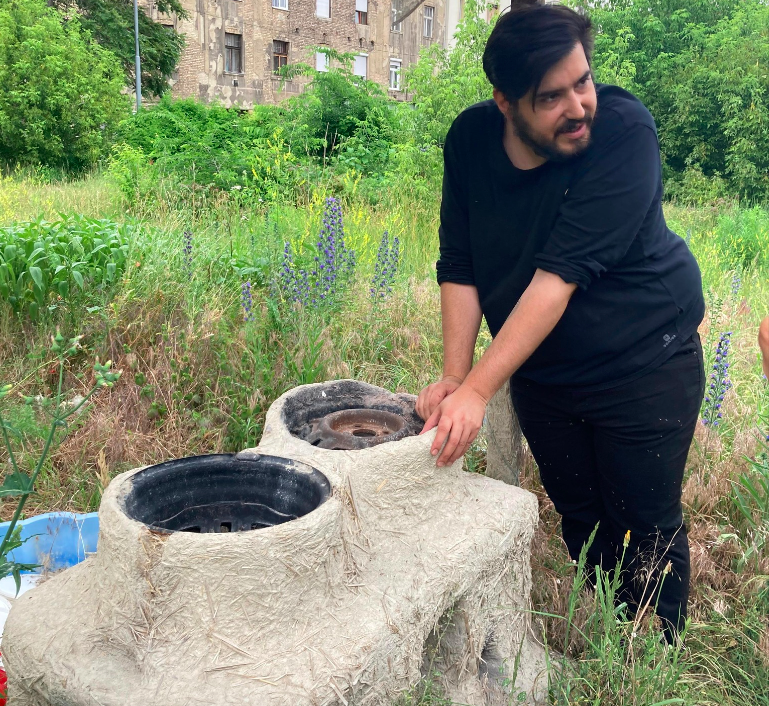
Can you give some examples of collaboration with other organisations?
We are in close contact with other similar communities, community centres, social hubs or cultural centres, like the bar and social centre Gólya, who bring their food waste to us, or Auróra and Lehetőségek tere, all located in the same district. We try to work together, help each other, and see how we can collaborate. For example there’s going to be a festival co-organised with Gólya the day after Midsummer’s weekend. They will provide drinks, put up sound systems for concerts and run workshops about nature, and we will cook some food. All of it is with the collaboration of Gólya, without whom it wouldn’t be possible to hold such an event because we don’t have the equipment or resources to do that.
How do the infamously anti-civic, anti-LMBTQ+ Hungarian government institutions and media view your activities?
There are conflicts and they are politically motivated. Because the mayor of the district is from the opposition party and next year there will be elections, currently a smear campaign is going on against us. The government media had several articles written about us, putting us in a negative light. To give some context, there is an annual fascist celebration taking place in February where fascists from all over the world travel to Budapest and gather at historic sites. This year, a number of antifa protesters travelled from Germany to confront them. There were allegations that some fascists were beaten by a number of antifa protestors. This caused a major uproar in the government media, and they started a smear campaign against all leftish organisations like Aurora, Gólya and us. The campaign went on and on. The tension was terrible.
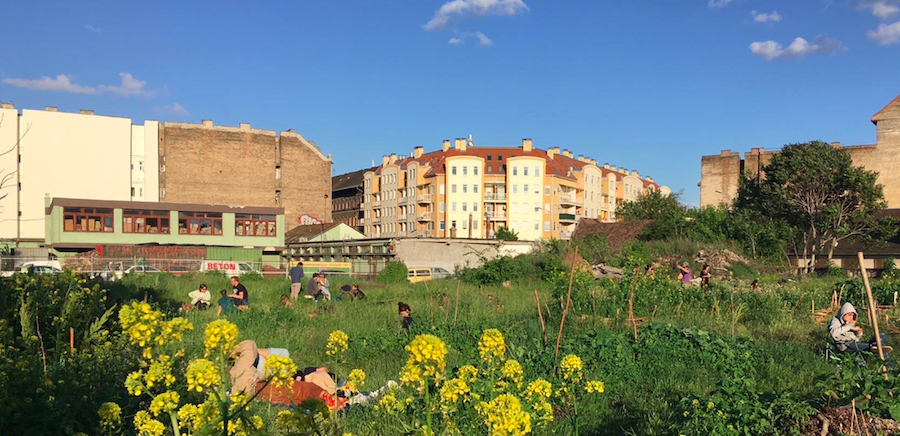
What is your relationship with the district?
The conflict with the district comes from the fact that they get a lot of pressure from government media due to being a progressive, left wing opposition administration. Imagine, when we have a huge smear campaign against us, the neighbours are worried, and they talk to the district. At the same time, the district is suing these papers, because they are providing completely false information. So there is a lot of tension, and we have to navigate in this atmosphere. We otherwise don’t have any conflict with the district, we actually try to collaborate with them as much as we can.
What is your relationship to the neighbours?
We try to make sure to make contact with the neighbours who are worried due to the smear campaign, we invite them in, make them interested in the space and what we do. We are working now on a campaign to make the outreach more effective, making the space sound more interesting to them. We distribute fliers in post boxes, we place information on doors or public areas, and most importantly, we talk to them when we are open.

Finally, can you tell us about your personal involvement with Szeszgyár? How did you end up here?
I knew the place for a long time because I live near here. I started to come to events and later I also started organising events. I already had an interest in permaculture and eco-feminism. I came here because of a mushroom workshop, learning about how to grow mushrooms at home.
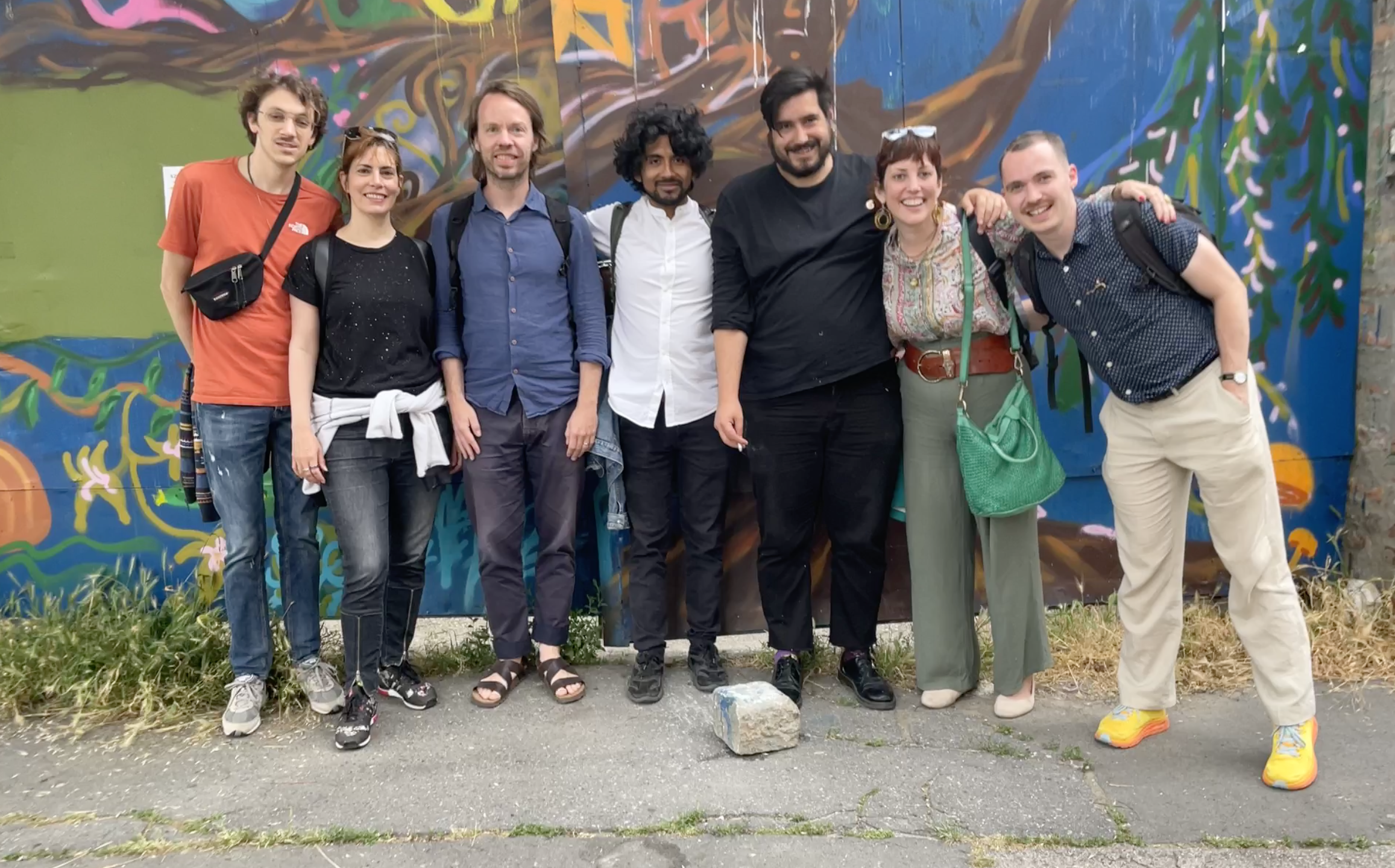
That always interested me, my actual family comes from a small village, and we always worked in the fields. If you’re a person who has that kind of history you want to continue doing that. It had been a while since I couldn’t work on the fields so that was a really important point. When the people who were running the place moved from Hungary, there was nobody who was going to continue. Three of us got together and decided to try to continue and keep the space open and functioning.

